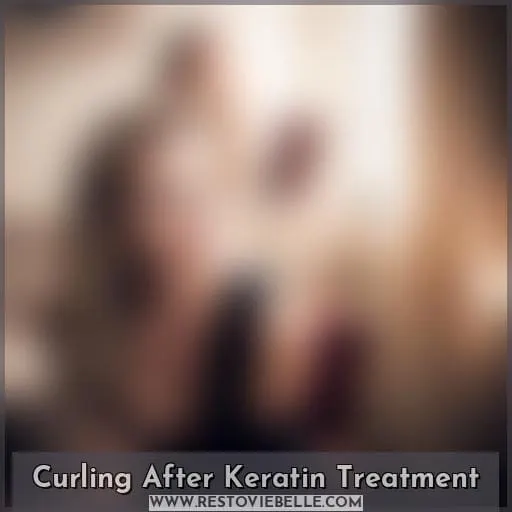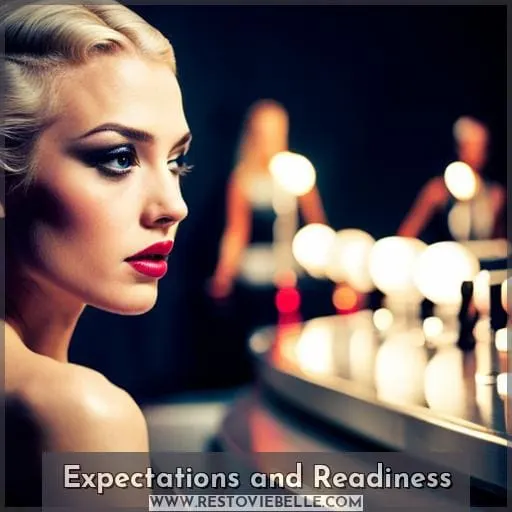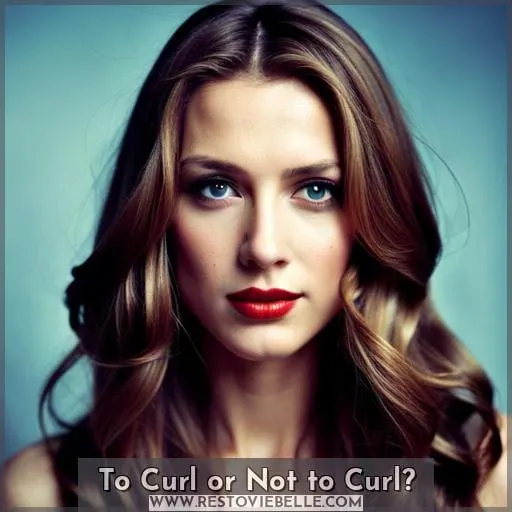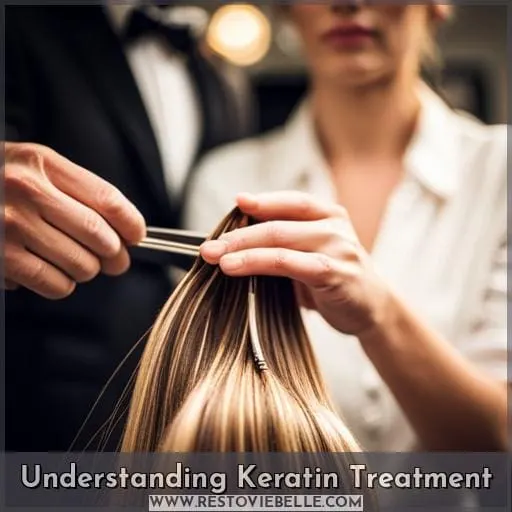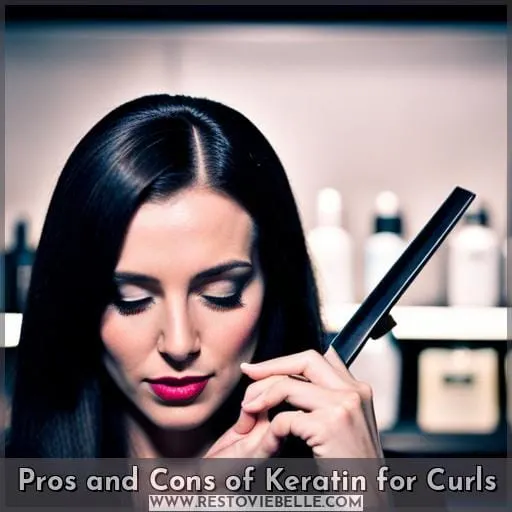This site is supported by our readers. We may earn a commission, at no cost to you, if you purchase through links.
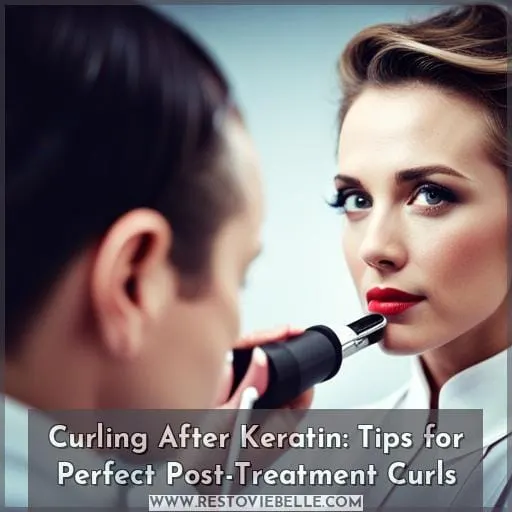 Step into a realm of hair transformation – envision a dance of curls cascading effortlessly post-keratin treatment.
Step into a realm of hair transformation – envision a dance of curls cascading effortlessly post-keratin treatment.
Yes, you can wield the power of curls after indulging in the smoothing magic of keratin.
Unveil the secrets to perfect post-treatment curls in this guide.
From optimal heat levels to understanding your hair’s readiness, embark on a journey where your tresses, treated with keratin’s finesse, embrace the liberating allure of curls.
It’s time to unlock the art of Curling After Keratin for a hair narrative that exudes power and sophistication.
Table Of Contents
- Key Takeaways
- Curling After Keratin Treatment
- Expectations and Readiness
- To Curl or Not to Curl?
- Understanding Keratin Treatment
- Pros and Cons of Keratin for Curls
- When Can You Safely Curl?
- Frequently Asked Questions (FAQs)
- How long do the curls last after curling keratin-treated hair?
- What size barrel curling iron works best for creating curls in keratin-treated hair?
- Can you use hairspray or other styling products when curling keratin-treated hair?
- Is it safe to use a curling wand on keratin-treated hair?
- What happens if you curl your hair too soon after a keratin treatment?
- Conclusion
Key Takeaways
- Consult your stylist before using heat tools post-treatment, conduct strand tests, and use quality tools with optimal heat settings to prevent damage.
- Fully check for keratin absorption and hair readiness before curling to avoid adverse effects.
- Focus on maintaining hair health with lower heat tools, varied styling techniques, and gentle handling in the first week post-treatment.
- Adjust approaches to curling by considering changes to texture and curl patterns after the keratin treatment.
Curling After Keratin Treatment
If you’re considering curling your hair after a keratin treatment, the easiest and safest option is to book a stylist for optimal results.
Before diving into styling, ensure the keratin has properly dried by running your fingers through your hair and abstain from washing it for the initial three days.
Conduct a strand test, choose the right curling tool, and set the heat levels appropriately to achieve perfect post-treatment curls that complement the benefits of your keratin treatment.
Easiest Option – Book a Stylist
If you want the simplest route to achieve flawless curls after a keratin treatment, book a stylist for expert assistance.
A hairstylist brings professional expertise to ensure optimal results. They can:
- Conduct a strand test
- Choose the right tools
- Set optimal heat levels
- Navigate your unique hair needs
This approach not only guarantees a stunning outcome but also minimizes the risk of unintended damage, leaving you with curls that complement the benefits of your keratin treatment.
Check Drying of Keratin
Ensure your keratin treatment has thoroughly dried before considering curling – a critical step for optimal styling results.
To check if the keratin has dried properly, run your fingers through the hair and feel for any residual moisture or stickiness.
It’s important to wait until the hair feels completely dry and smooth to touch before proceeding with curling. This will ensure that you achieve long-lasting curls without compromising the effectiveness of the keratin treatment.
Strand Test Before Curling
Before diving into the full curling process after your keratin treatment, take a moment to conduct a strand test to gauge the readiness of your hair for styling.
Assess Keratin Absorption: Ensure the keratin treatment has fully absorbed for smooth styling.
Optimal Heat Selection: Set the curling iron to a lower heat setting to protect the keratin coating.
Heat Protectant Application: Apply a heat protection spray to shield the hair from direct heat.
Consider Curling Alternatives: Evaluate if curling is the best option or embrace your hair’s natural texture.
Choosing the Right Curling Tool
Selecting a high-quality curling iron is crucial for achieving perfect curls after undergoing a keratin treatment.
Opt for a curling tool, such as the ghd Soft Curl Hair Curling Iron or the InfinitiPro Multi-Style by Conair, that offers precise temperature control and even heat distribution.
Consider the desired curl type – whether relaxed waves or tighter curls – and choose a barrel size accordingly.
Prioritize heat protection with a quality heat protectant spray to ensure the longevity of your keratin-treated hair while experimenting with various curling techniques.
Setting Optimal Heat Levels
Now, transition seamlessly from choosing the right curling tool by focusing on optimizing your styling process with the crucial step of setting optimal heat levels for curling after a keratin treatment.
Ensure you’re aware of how the heat can impact your treated hair for the best results.
Implementing optimal heat settings, along with using sulfate-free products and consulting with a stylist, is essential to preserve the benefits of your Brazilian keratin treatment and maintain healthy, beautifully styled curls.
Expectations and Readiness
Before diving into the world of post-keratin curls, ensure you comprehend the intricacies of expectations and readiness.
Understanding the dynamics of managing the first week after treatment, optimizing curl intensity, and styling with the benefits of keratin in mind is paramount. This knowledge sets the foundation for a seamless transition from the treatment chair to effortlessly perfect post-treatment curls.
Understanding Post-Keratin Curls
Assessing your hair’s readiness after the keratin treatment is vital for achieving impeccable curls.
- Bond breakdown
- Protein levels
- Overall hair health
Expect a different curl pattern due to the treatment, necessitating adjustments in curling techniques.
Prioritize heat protectants and suitable styling products for maintaining the treatment’s benefits.
Embrace the evolution in your hair’s texture and employ maintenance tips to ensure enduring, post-keratin curls.
Managing First Week After Treatment
During the initial week following your keratin treatment, handle your hair delicately and monitor its readiness for styling.
Practice meticulous care, ensuring sufficient moisture and employing heat protection.
Embrace patience in preparation for curling after keratin treatment, nurturing your hair with sulfate-free styling sprays and clarifying shampoos.
Optimal post-treatment care lays the foundation for healthy, beautiful curls while safeguarding your hair’s integrity.
Optimizing Curl Intensity
To optimize your curl intensity after a keratin treatment, ensure your hair is fully ready for styling before diving into the curling process.
- Prep with Heat Protection: Apply a quality heat protectant to shield hair during styling.
- Consider Barrel Size: Choose a barrel size based on desired curl tightness.
- Long-Term Styling Techniques: Embrace styling methods that maintain curls post-treatment.
Styling With Keratin’s Benefits in Mind
When styling post-keratin, leverage keratin’s benefits while assessing hair readiness.
Consider gentle curling techniques, embracing natural texture, and choosing quality tools for optimal results.
Prioritize heat protection, maintain hair health, and extend longevity with proper care.
Explore various styling variations, from air-drying to using quality curling irons, ensuring you cater to your hair’s needs while tending to split ends and managing humidity for impeccable curls.
To Curl or Not to Curl?
Sure, diving into post-keratin curling, consider initial factors before styling.
Embrace your hair’s natural texture for a while, exploring alternatives to curling after the treatment.
Assess readiness and expectations to decide whether to opt for curls or explore other styling options post-keratin.
Considerations Before Curling
Before deciding whether to curl your hair after a keratin treatment, important factors to consider include:
- Heat protection
- Hair readiness
- Strand testing
Opt for optimal tools and gauge the desired curl intensity. Assess if your hair is ready for styling curly waves or beachy waves post-keratin for the ideal wave pattern.
Consider these elements to ensure perfect post-treatment curls without compromising the keratin’s benefits.
Embracing Natural Texture
Considering the previous details about the keratin treatment’s impact on your hair, it’s crucial to embrace its natural texture as you weigh the decision of whether to curl or not.
- Enhancing Texture: Celebrate the newfound texture without altering it excessively.
- Texture Transition: Allow for a graceful transition between treated and untreated sections.
- Natural Curls: Embrace the beauty of your hair’s innate curl pattern.
- Texture Appreciation: Appreciate the uniqueness of your natural texture post-treatment.
- Texture Embrace: Embrace the confidence that comes with owning your natural texture.
Alternatives to Curling After Keratin
If curling your hair after a keratin treatment isn’t the route you want to take, there are alternative options to explore. Consider embracing your natural texture or transitioning to different styling methods.
Maintenance involves using a suitable brush for your hair type and allowing cooling curls to set. Understanding how often keratin treatment suits your hair will aid in making the right styling decisions.
Understanding Keratin Treatment
Keratin treatments, involving the temporary bonding of hair structures using formaldehyde, offer a respite from frizz and facilitate easier styling. These treatments provide a range of benefits, from managing frizz in humid conditions to creating smoother, more manageable locks.
Understanding the process, types, and advantages of keratin treatment sets the stage for effectively caring for and styling treated hair.
Process and Purpose of Keratin Treatment
During a keratin treatment, your hair undergoes a process where a specialized formula, often containing formaldehyde, creates temporary bonds within the hair structure.
The treatment coats your strands with keratin protein to smooth the cuticle and straighten curls.
Using heat protection, proper maintenance, and avoiding over-processing lets you curl hair occasionally before the effects wear off.
Types of Keratin Treatments
The two main types of keratin treatments you’ll encounter are formaldehyde and formaldehyde-free.
Formaldehyde treatments are harsher but longer-lasting, requiring straightening precautions for 3-4 months.
Formaldehyde-free options utilize safer ingredients, providing 2-3 months of smoother, frizz-free hair with fewer straightening limitations.
Weigh your styling preferences and maintenance capabilities when selecting treatment types.
Benefits of Keratin for Hair
To fully understand the benefits of keratin for hair, it’s essential to delve into the process and purpose of keratin treatments.
- Smoothing and frizz elimination
- Enhanced manageability
- Soft, silky texture
- Damage repair and added strength
When used properly with heat protection and the right products, keratin’s durability allows for versatile styling like curling when timing aligns.
Pros and Cons of Keratin for Curls
When considering a keratin treatment for your curls, there are advantages and potential drawbacks to weigh.
The smoothing and frizz elimination can make styling easier, but the results are temporary, lasting around 3-4 months.
Also keep in mind that some formulas contain formaldehyde, which requires caution when frequently treating curly hair.
Advantages of Keratin for Curls
You’re moving from understanding keratin treatments into considering both the advantages for your curls along with potential drawbacks to weigh.
Keratin’s curl benefits include added shine and definition from the treatment’s smoothing properties. By styling safely with heat protection and proper post-treatment care, you enable diverse curling techniques for versatile looks.
Potential Drawbacks to Consider
When embracing keratin’s advantages for your curls, you’ll also need to weigh some potential drawbacks:
- Frequent touch-ups required to maintain results
- Potential damage from heat styling without precautions
- Financial commitment for initial and maintenance treatments
- Need to adapt curling techniques for treated hair
When Can You Safely Curl?
Before curling your hair post-keratin treatment, it’s crucial to assess if the keratin has been fully absorbed.
Look for signs like:
- The ability to run your fingers through your hair without catching.
- A minimum 3 day period without washing to allow proper processing.
Once you’ve determined the keratin is set, conduct a test curl on a small section first to evaluate the hair health and readiness for heat styling.
Waiting Period After Treatment
Depending on when your stylist gives you the go-ahead, you can safely curl your hair after the keratin treatment once it’s fully settled in your strands.
Wait at least 72 hours post-treatment before heat styling to allow proper sealing of the keratin bonds.
Assess hair sensitivity and heat tolerance with a small test curl first.
Exercise patience in the initial post-treatment stage to maximize lasting frizz elimination and ease of styling.
Signs of Proper Keratin Absorption
With the keratin having fully penetrated the hair shaft, you can safely proceed with curling your tresses about one week post-treatment.
- Smooth texture without frizz or flyaways
- Soft, silky feel from roots to ends
- Ability to comb through strands without resistance
- Loss of volume indicating the bonding process is complete
Assessing Hair Health Before Curling
Once you’ve confirmed proper keratin absorption through signs like smoothness and manageability, it’s crucial you thoroughly assess your hair’s:
- Moisture
- Elasticity
- Heat sensitivity
- Scalp condition
- Protein balance
before attempting any curls.
Check for brittleness, dryness, or damage, and confirm your hair can withstand heat styling without harm.
Frequently Asked Questions (FAQs)
How long do the curls last after curling keratin-treated hair?
The curls can last up to 24 hours after curling keratin-treated hair.
Use heat protectant, limit heat tool temperature and frequency of use, and allow curls to cool completely before touching to maximize longevity.
Proper aftercare is crucial for retaining beautiful curls without causing damage.
What size barrel curling iron works best for creating curls in keratin-treated hair?
Choose a 1 or 25-inch barrel to achieve the perfect bounce and wave in keratin-treated hair.
Larger barrels, over 5 inches, won’t hold the curl as well.
Smaller barrels under 1 inch can over-curl and create tight ringlets.
Can you use hairspray or other styling products when curling keratin-treated hair?
Yes, you can use hairspray or other styling products when curling keratin-treated hair.
Apply them sparingly and focus on the ends to avoid product buildup.
Let curls cool completely before touching to set the style.
Gentleness is key when manipulating fragile treated strands.
Is it safe to use a curling wand on keratin-treated hair?
Yes, curling wands are generally safe for keratin-treated hair when used properly.
Be sure to apply a heat protectant spray first and use lower heat settings to avoid damage.
Gently wrap hair around the barrel without excessive pulling or pressure.
Allow hair to cool completely before brushing out curls.
What happens if you curl your hair too soon after a keratin treatment?
Curling your hair too soon after a keratin treatment can disrupt the bond and affect the longevity of the treatment. It’s crucial to wait for at least one week to allow the keratin to settle before curling for optimal results.
Conclusion
Embrace the power and sophistication of perfect post-keratin treatment curls with these tips for curling after a keratin treatment.
Whether you choose to book a stylist or curl at home, it’s important to check the drying of the keratin and perform a strand test before curling.
Select the right curling tool and set optimal heat levels to achieve the desired results.
Understand post-keratin curls and manage the first week after treatment for best outcomes.
Consider the pros and cons of keratin for curls and make an informed decision.
